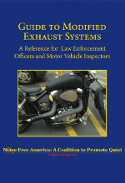The “Excessive or Unusual Noise" Enforcement
 The motor vehicle exhaust noise and muffler laws of practically all 50 states have one key phrase in common: “excessive or unusual noise." The simple observation of excessive or unusual noise is the enforcement criterion employed by most police officers when enforcing motor vehicle noise and muffler laws.
The motor vehicle exhaust noise and muffler laws of practically all 50 states have one key phrase in common: “excessive or unusual noise." The simple observation of excessive or unusual noise is the enforcement criterion employed by most police officers when enforcing motor vehicle noise and muffler laws.
Although establishing prohibited decibel levels in noise pollution regulations has its place in some instances (such as for products distributed into commerce at the regulatory level), dealing with everyday "in use" and local noise pollution issues by establishing "allowed noise" levels expressed in decibels is not the best way to address the problem, especially for enforcement purposes (and especially for mobile and transient sources of noise such as motorcycles).
Employing a decibel-level based approach for establishing "allowed" noise levels implies that one is "allowed" to make noise and gives the impression that the noise one is "allowed" to make must be assessed by performing decibel-level noise measurements; that approach is inherently enforcement inhibiting and puts a damper on having such noise pollution policies enforced. It is far better to establish what a noisemaker can't do rather than what a noisemaker can do.
The simple observation of "excessive or unusual noise" emitted by a loud motorcycle provides the police with valid probable cause to stop and ticket its operator. That simple enforcement criterion has been upheld by the appellate courts as both objective and constitutional. The police should not hesitate to employ it.

 Preview
Preview